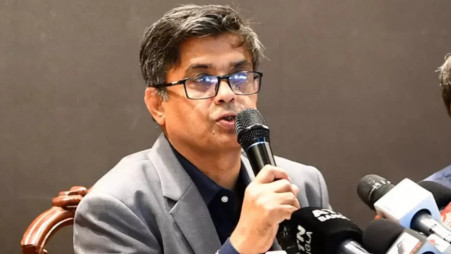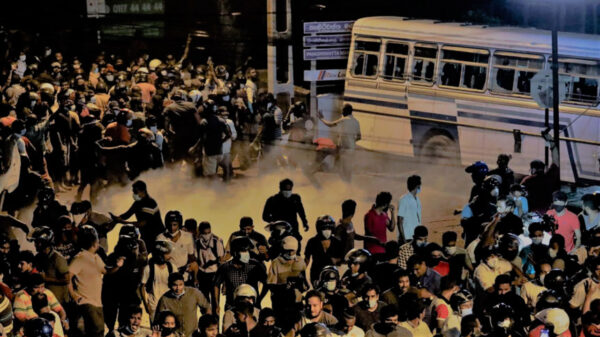Sri Lanka is going through a period of political unrest amid its ongoing economic crisis. The government, led by an influential family, is on the verge of collapsing.
Once touted to become the Singapore of South Asia, the country with a 100 percent literacy rate and a per capita income of four thousand US dollars has now become a loan defaulter.
Initiating largescale mega projects based on foreign loans, reduction of remittance through legal channels, the negative impact of the Covid-19 pandemic on tourism and a plethora of other factors contributed to this ill fate.
In terms of economic indicators, Bangladesh is in a much more comfortable position than Sri Lanka. However, economic experts are asking whether the current state will persist for another four-five years.
In an interview with The Daily Star, Professor Muinul Islam, Ekushey Padak-winning economist and former teacher of Chittagong University, said Bangladesh is in no imminent danger but is concerned by the unnecessary projects the country has started.
Question: Sri Lanka had a better per capita income than us, so why are they in such turmoil?
Answer: Sri Lanka’s import capability is now virtually non-existent. From 2009-2019, they made a lot of mistakes, but they made some massive blunders in 2019. President-elect Gotabaya Rajapaksa reduced VAT to eight percent from 15 and also withdrew the rebuilding tax. This caused the government’s revenue to fall by 30 percent overnight.
In 2019, they banned importing chemical fertilisers and pesticides in favour of natural agricultural processes. Thus, their agro and food production collapsed and fell by a third. At that moment, the Covid-19 pandemic struck and income from tourism — their largest source of income — ceased to exist.
Simultaneously, remittance coming through legal channels fell by 85 percent. Getting more money through informal channels, people completely stopped using legal channels. As this money never came in legally, the government could not utilise it to import goods.
Similarly, in our country, we get about $10-12 billion dollars through informal channels, but we also get $20-22 billion from legal channels. Remittance plays a big role in bridging trade gaps. With the sharp decline in remittance, Sri Lanka’s foreign reserve depleted rapidly.
The country was self-sufficient in food. The production collapse caused them to spend $450 million for food import. This caused their reserves to dwindle to $50 million and so they are not able to import food, fuel or medicine.
Although Sri Lanka had a handsome per capita income, that money does not enter everyone’s pockets. Right now, the country is experiencing severe inflation. The Sri Lankan rupee is pegged to 315 to 330 against each US dollar. As a whole, their economy has totally collapsed.
Q: Many Bangladeshis think Sri Lanka was entrapped by Chinese loans, which caused their current sorry state. Is this true?
A: It’s not entirely true. They implemented a lot of unnecessary projects using Chinese loans – for example the Hambantota Sea Port, Rajapakse International Airport, Chinese Colombo City and a few highways. They also collected $9 billion from the international market in exchange of debt bonds. As a whole, the foreign debt reached $51 billion, whereas their GDP was only $80 billion.
When the time came to repay the loans, they got an instalment valued at $8 billion. Unable to pay this amount, they were forced to declare themselves bankrupt.
However, the main reasons behind the problem are reduction in revenue, fall in production due to adopting natural agricultural processes, reduction in remittance through legal channels and the tourism sector’s stagnation thanks to the pandemic.
Now, similar to Pakistan, they too are going from door to door to find a way out. They also reached out to the IMF, which will certainly impose a lot of conditions. As long as the political turmoil persists, IMF will not give a single penny.
Pakistan’s PM Shehbaz Sharif managed to get $8 billion from Saudi Arabia, but it is unlikely that the Kingdom will give money to Sri Lanka. India gave $3 billion. China restructured the loans, but they are not willing to extend any additional amount.
Thus, in order to get a solution, they have to depend on IMF or India, or any other country willing to give them more loans. If the country can resume imports using that money, they may slowly turn things around.
Q: Economists are repeatedly explaining that none of the indicators say Bangladesh may suffer a similar fate.
A: Bangladesh is in no imminent danger, but we too have started a lot of unnecessary projects. As an example, we have taken a loan of $12 billion from Russia and spent Tk 1,13,000 crore [$13 billion approximately] to implement the Rooppur Nuclear Power plant, which has a meagre production capacity of 2,400 megawatts. It’s the worst kind of white elephant project. They claim we can repay the debt in 20 years. But when the instalments will resume in 2025, every year we have to pay $565 million.
The railway project for the Padma bridge has a budget of Tk 40,000 crore [$4.6 billion]. When the roads become operational, the cost of using railway will never remain feasible. The income we will get from this will never facilitate loan repayment. Thus, this will become a massive burden for Bangladesh.
Another such project is the railway link to Cox’s Bazar, with an expenditure of Tk 18,000 crore [$2.1 billion]. This was supposed to be built as part of the economic corridor linking Bangladesh, China, India, Myanmar. But that corridor has met an early demise thanks to India’s exit. This ADB funded project’s income will never be enough to cover repayments.
The Payra port was supposed to be a deep-sea port. Several hundred crore taka has already been spent on it. But now it is being built as a regular sea port instead of a deep-sea port. China financed the Payra power plant, but they did not give any loans. Thus, this project is not likely to become a burden.
We kept on taking one project after another without doing any proper economic feasibility studies. This kind of random decision making has motivated discussions such as building a new airport, a second Padma bridge, launching another satellite, shifting Dhaka elsewhere and starting bullet-train service between Dhaka and Cox’s Bazar. All of these are unnecessary projects and none sheds any light upon the bigger picture. If implemented, all of them will require additional debt. Our loan instalments will surpass the $4 billion mark by 2025.
We also have a huge amount of internal debt. If we add these two, our debt-to-GDP ratio will surpass the 50 percent mark. It is a very risky situation. We are going towards it fast. Thus, if we cannot control ourselves from taking local and foreign loans and random projects, we too will reach Sri Lanka’s situation within four-five years.
This year, our imports are set to reach the $82-85 billion level, but export is only $50 billion. The trade deficit of $32-35 billion cannot be bridged by remittance alone. We will therefore have to live with around a $10 billion shortfall this year.
In the last eight months, our reserves fell to $42 billion from $48 billion. In the next two months, it may fall by another $4 billion. If the current trend of more imports against exports continues, and if we fail to bridge the gap with remittance, very soon our reserves will also start to deplete. When the reserves will reach risky levels, the value of the taka will fall too. In such a situation, our economy will wade dangerous waters and all commodity prices will increase. The comfortable situation we are in now will no longer be there.























